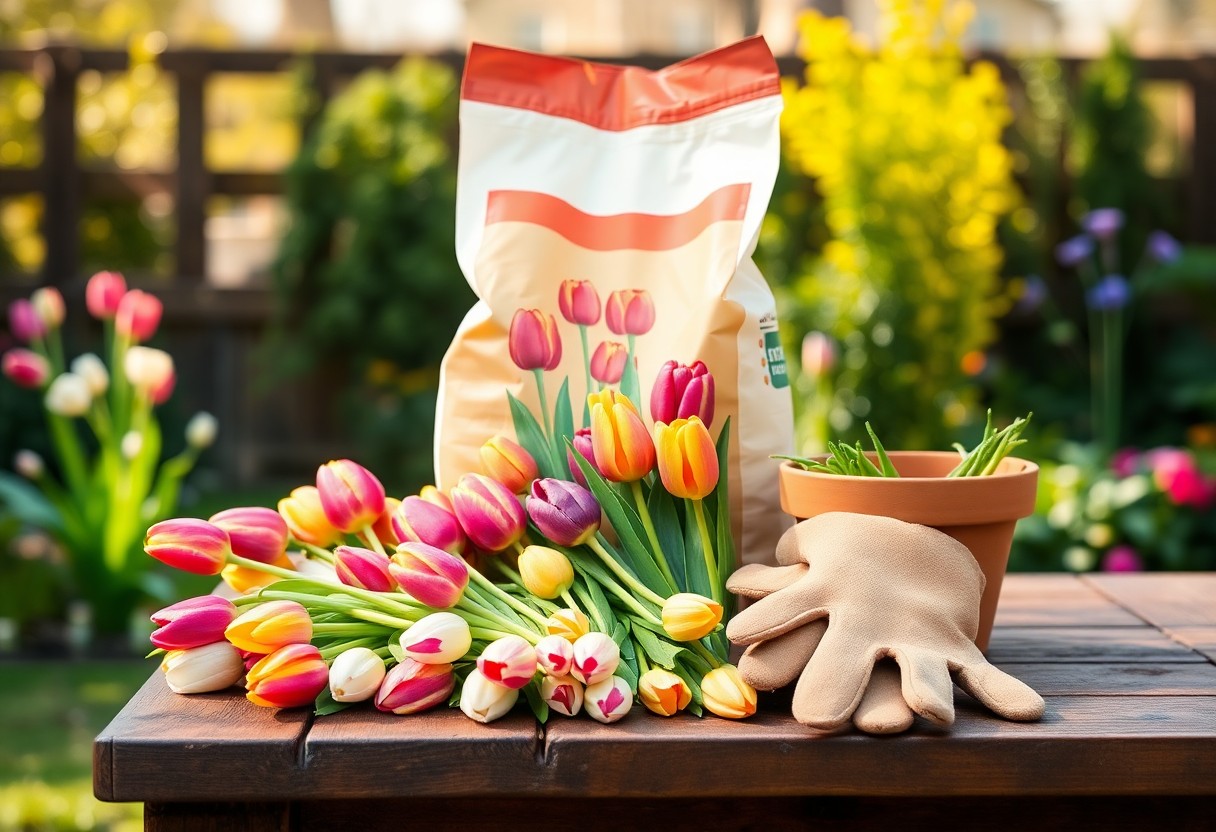
Most spring gardens aren’t complete without the vibrant and cheerful bloom of tulips, and planting them in pots is a fantastic way to enjoy their beauty even in limited spaces. In this guide, you’ll learn how to successfully plant tulips in containers, ensuring they thrive and add color to your patio or balcony. With a few simple steps and tips, you can create a stunning display that brightens your outdoor space! Let’s get started on this colorful journey together.
Choosing the Right Pots
While selecting pots for your tulips, it’s imperative to consider their material and style. Opt for containers that complement your garden or home décor while providing the necessary space for your tulips to thrive. Look for pots with adequate depth and width, allowing the bulbs room to grow. Keep in mind, the right pot will not only enhance your garden’s beauty but also promote healthy growth for your tulips.
Size Matters
Any pot you choose should be spacious enough to accommodate the tulip bulbs comfortably. A good rule of thumb is to select a container that is at least 8 inches deep and wide, as this gives the bulbs the necessary room to develop properly. Remember that overcrowded bulbs can lead to poor growth and inadequate blooming, so opt for larger pots when planting multiple bulbs.
Drainage is Key
Even the most beautiful pot won’t help your tulips if it retains too much water. Adequate drainage is vital to prevent root rot and ensure your bulbs thrive. Make sure your chosen pots have drainage holes at the bottom, allowing excess water to escape easily. Moreover, consider adding a layer of gravel or small stones at the bottom before planting, which will further enhance drainage and improve air circulation around your tulip bulbs.
With good drainage, your tulips will have a better environment to grow and bloom beautifully. Proper water management helps to maintain healthy roots, preventing soggy conditions that can lead to disease. By ensuring that excess water can escape, you’re giving your tulips the best possible chance to flourish in their pots. So, as you prepare your pots, keep drainage in mind as a key factor in your tulip gardening success.
Selecting Tulip Varieties
There’s a delightful array of tulip varieties to choose from when planting in pots. You can select based on bloom time, height, and color to create a stunning display. Look for varieties that suit your personal taste and complement your outdoor space. Whether you prefer classic single tulips or fringed petals that add texture, the choice is all yours!
Spring Bloomers vs. Late Bloomers
While choosing tulips, consider the bloom time that best fits your garden schedule. Spring bloomers, like Darwin hybrids, provide early bursts of color, while late bloomers, such as Triumph and Parrot tulips, offer extended enjoyment throughout spring. Mixing both can ensure a continuous show of beautiful blooms in your pots!
Color Choices and Combinations
Clearly, color plays a significant role in your tulip selection. You can create vibrant contrasts or soothing monochromatic displays to match your style.
Tulip varieties come in a rainbow of colors, so think about the mood you want to create. Combining warm hues, like reds and yellows, invokes energy, while cool colors like purple and white lend a tranquil feel. You can also experiment with various heights and shapes to add visual interest. By carefully mixing shades and forms, you can design a stunning display that will enchant throughout the spring season.
Essential Planting Tips
One of the keys to successfully planting tulips in pots is to follow some crucial tips.
- Choose the right pot with drainage holes.
- Select high-quality bulbs.
- Use well-draining potting soil.
- Water your bulbs after planting.
Assume that you’ve taken care of these basics, and your tulips will thrive beautifully.
Timing Your Planting
The best time to plant your tulip bulbs is in the fall, about six to eight weeks before the first frost. This allows them to establish roots before the ground freezes, ensuring vibrant blooms when spring arrives. Planting at this right moment also helps them acclimate to their new pot environment, setting you up for a colorful display.
Planting Depth and Spacing
Even spacing and proper depth are key to your tulips’ health. Plant your tulip bulbs about six to eight inches deep and space them about four to six inches apart for optimal growth and airflow.
A good rule of thumb for planting depth is to place the bulb pointed side up in the soil. This depth protects the bulbs from freezing temperatures and helps the roots establish well in the potting soil. Spacing the bulbs allows each flower to emerge without crowding, ensuring that each tulip has ample room to bloom beautifully. Your efforts will be rewarded with a stunning display of color in your garden or patio!
Soil and Fertilization
For the best results when planting tulips in pots, it’s important to choose the right soil and fertilization strategy. A well-draining mix not only ensures healthy root development but also prevents waterlogging, which can harm your bulbs. You can enhance your potting mix with organic matter or a balanced fertilizer to provide your tulips with the nutrients they need as they grow.
Best Soil Mix for Tulips
Some of the best soil mixes for tulips include a combination of high-quality potting soil, perlite, or coarse sand. This blend promotes good drainage while retaining enough moisture for the bulbs. Adding compost can also give your tulips the nutrients necessary for vibrant blooms, making your container garden a beautiful sight.
When and How to Fertilize
Assuming you have chosen an excellent soil mix, fertilizing your tulips can enhance their growth. Apply a balanced liquid fertilizer every couple of weeks during the growing season, but be cautious not to over-fertilize, as this can lead to excessive foliage growth at the expense of flowers.
Understanding the timing and method of fertilization will set you up for success with your tulip pots. Start fertilizing about four to six weeks after planting, as this is when the bulbs begin to actively grow. Make sure to follow the label directions for dilution and application, focusing on evenly distributing the fertilizer around the base of your tulips. This approach will help nourish the bulbs throughout their blooming season, leading to vibrant and healthy flowers.
Watering and Maintenance
Now that you’ve successfully planted your tulips in pots, it’s time to focus on watering and maintenance to keep your blooms healthy and vibrant. As the tulips grow, you’ll need to pay attention to their specific watering needs and provide care that enhances their beauty. By following a few simple steps, you can ensure a stunning display when your tulips bloom.
Watering Guidelines
To keep your potted tulips thriving, water them thoroughly after planting and ensure the soil remains consistently moist but not soggy. You can check the moisture level by sticking your finger about an inch into the soil; if it feels dry, it’s time to water. Adjust your watering frequency based on the weather—hot, windy days might need more frequent watering.
Caring for Your Potted Tulips
Guidelines for the maintenance of your potted tulips include providing adequate sunlight and monitoring for pests. Place your pots in a location where they can receive at least 6 hours of sunlight daily and consider rotating them if one side seems to get more light than the other. Regularly inspect your plants for any signs of disease or pests, and take action promptly if you notice anything unusual.
Watering your tulips appropriately will support their overall health. After establishing a routine, adjust the watering based on the environment. During blooming, you may need to increase watering slightly, while in cooler months, you might reduce it. Sunshine, well-drained soil, and consistent watering will create an inviting space for your tulips to flourish, giving you a splendid display in your pots.
Dealing with Pests and Diseases
To ensure your tulip pots thrive, it’s important to keep an eye out for pests and diseases that can affect their growth. Regular inspections will help you spot issues early, allowing you to take appropriate action to keep your tulips healthy and vibrant.
Common Pests to Watch For
If you notice your tulips wilting or having discolored leaves, you may have encountered common pests like aphids or spider mites. These critters can quickly wreak havoc on your beautiful blooms, so vigilance is key.
Preventative Measures
Any gardener can benefit from implementing a few simple strategies to keep pests at bay, such as choosing disease-resistant varieties and ensuring proper care and maintenance of your pots.
Preventative measures include maintaining good air circulation around your plants and using organic insecticides if pests become an issue. Regularly cleaning your pots and removing any dead foliage can also discourage pests from taking up residence. Additionally, water your tulips at the base rather than overhead to minimize mold and fungi growth. Taking these steps will contribute to a healthy growing environment for your tulips!
Conclusion
Drawing together the tips for planting tulips in pots, you can easily create a beautiful display right on your patio or balcony. Ensure you choose the right pot size, provide excellent drainage, and select healthy bulbs. By layering potting mix and bulbs thoughtfully, you will enjoy vibrant blooms that brighten your space. With a little patience and care, your tulips will flourish, adding color and joy to your gardening experience.







